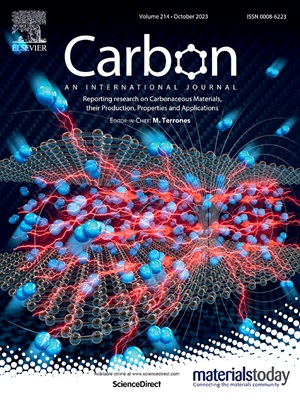Magnetic carbon fibers with hierarchical porous structure for efficient electromagnetic wave absorption and interference shielding
IF 11.6
2区 材料科学
Q1 CHEMISTRY, PHYSICAL
引用次数: 0
Abstract
Hierarchical porous structure and electromagnetic (EM) synergy are two important factors in manipulating EM wave absorption and EM interference shielding. Inspired by this thought, herein, a series of magnetic carbon fibers with both hierarchical porous structure and synergistic effect are successfully fabricated by the electrospinning through adjusting the pyrolysis temperature and adding pore-forming agents. Results demonstrate that NiFe Prussian blue analogues derivatives are uniformly distributed in the interior of carbon fibers and induce magnetic loss, the carbonization of poly(methyl methacrylate) and β-cyclodextrin produce hierarchical micro-meso-macropores and the carbon fiber networks provide highly long-range conductive pathways. Benefiting from the cooperative advantages, the fabricated magnetic carbon fibers display high-efficient EM wave absorption and EMI shielding. The minimum reflection loss is −59.4 dB and the absorption bandwidth reaches as wide as 10.2 GHz. Furthermore, the absorption-dominated shielding effectiveness (SE) achieves 18.5 dB. This study provides a simple method in modulating porous structure and inspires a valuable guideline for designing strong-absorption EM interference shielding materials.

具有分层多孔结构的磁性碳纤维具有有效的电磁波吸收和干扰屏蔽作用
分层多孔结构和电磁协同作用是控制电磁波吸收和屏蔽电磁干扰的两个重要因素。在此思想的启发下,本文通过调整热解温度和添加成孔剂,采用静电纺丝的方法成功制备了一系列既有分层多孔结构又有协同效应的磁性碳纤维。结果表明,NiFe普鲁士蓝类似衍生物在碳纤维内部均匀分布并引起磁损失,聚甲基丙烯酸甲酯和β-环糊精的碳化产生分层的微-中-大孔,碳纤维网络提供了长距离的导电途径。利用协同优势,制备的磁性碳纤维具有高效的电磁波吸收和电磁干扰屏蔽性能。最小反射损耗为- 59.4 dB,吸收带宽达到10.2 GHz。此外,吸收主导的屏蔽效能(SE)达到18.5 dB。该研究提供了一种简单的多孔结构调制方法,为强吸收电磁干扰屏蔽材料的设计提供了有价值的指导。
本文章由计算机程序翻译,如有差异,请以英文原文为准。
求助全文
约1分钟内获得全文
求助全文
来源期刊

Carbon
工程技术-材料科学:综合
CiteScore
20.80
自引率
7.30%
发文量
0
审稿时长
23 days
期刊介绍:
The journal Carbon is an international multidisciplinary forum for communicating scientific advances in the field of carbon materials. It reports new findings related to the formation, structure, properties, behaviors, and technological applications of carbons. Carbons are a broad class of ordered or disordered solid phases composed primarily of elemental carbon, including but not limited to carbon black, carbon fibers and filaments, carbon nanotubes, diamond and diamond-like carbon, fullerenes, glassy carbon, graphite, graphene, graphene-oxide, porous carbons, pyrolytic carbon, and other sp2 and non-sp2 hybridized carbon systems. Carbon is the companion title to the open access journal Carbon Trends. Relevant application areas for carbon materials include biology and medicine, catalysis, electronic, optoelectronic, spintronic, high-frequency, and photonic devices, energy storage and conversion systems, environmental applications and water treatment, smart materials and systems, and structural and thermal applications.
 求助内容:
求助内容: 应助结果提醒方式:
应助结果提醒方式:


